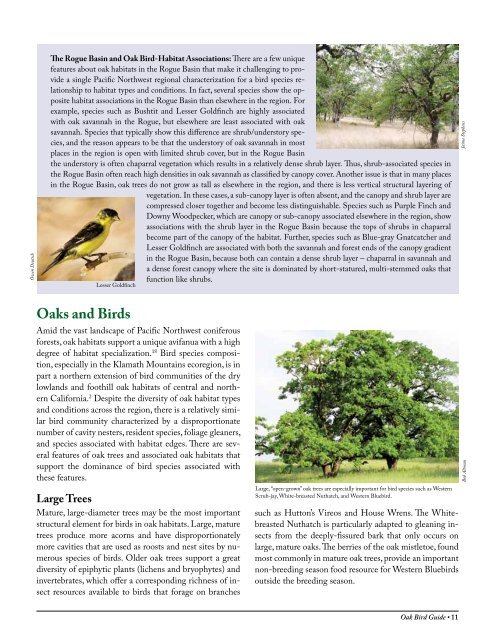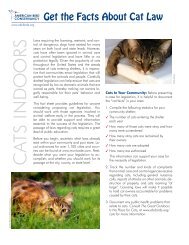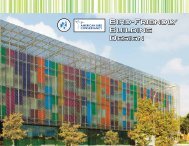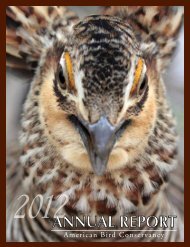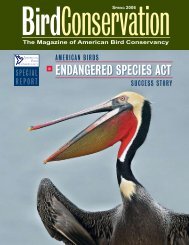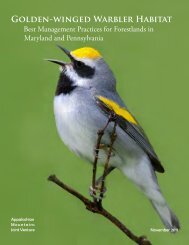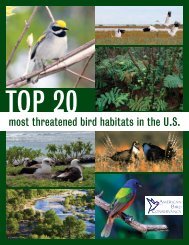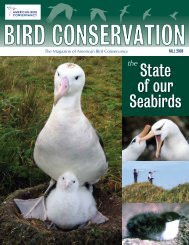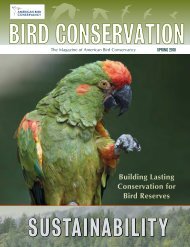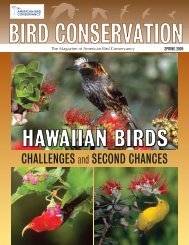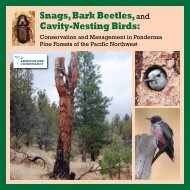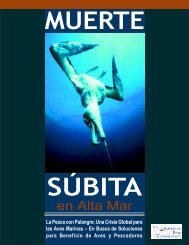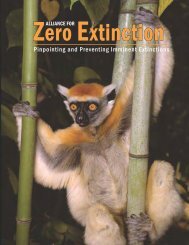Oak Ecosystems in the Pacific Northwest - American Bird Conservancy
Oak Ecosystems in the Pacific Northwest - American Bird Conservancy
Oak Ecosystems in the Pacific Northwest - American Bird Conservancy
You also want an ePaper? Increase the reach of your titles
YUMPU automatically turns print PDFs into web optimized ePapers that Google loves.
Owen Deutsch<br />
The Rogue Bas<strong>in</strong> and <strong>Oak</strong> <strong>Bird</strong>-Habitat Associations: There are a few unique<br />
features about oak habitats <strong>in</strong> <strong>the</strong> Rogue Bas<strong>in</strong> that make it challeng<strong>in</strong>g to provide<br />
a s<strong>in</strong>gle <strong>Pacific</strong> <strong>Northwest</strong> regional characterization for a bird species relationship<br />
to habitat types and conditions. In fact, several species show <strong>the</strong> opposite<br />
habitat associations <strong>in</strong> <strong>the</strong> Rogue Bas<strong>in</strong> than elsewhere <strong>in</strong> <strong>the</strong> region. For<br />
example, species such as Bushtit and Lesser Goldf<strong>in</strong>ch are highly associated<br />
with oak savannah <strong>in</strong> <strong>the</strong> Rogue, but elsewhere are least associated with oak<br />
savannah. Species that typically show this difference are shrub/understory species,<br />
and <strong>the</strong> reason appears to be that <strong>the</strong> understory of oak savannah <strong>in</strong> most<br />
places <strong>in</strong> <strong>the</strong> region is open with limited shrub cover, but <strong>in</strong> <strong>the</strong> Rogue Bas<strong>in</strong><br />
<strong>the</strong> understory is often chaparral vegetation which results <strong>in</strong> a relatively dense shrub layer. Thus, shrub-associated species <strong>in</strong><br />
<strong>the</strong> Rogue Bas<strong>in</strong> often reach high densities <strong>in</strong> oak savannah as classified by canopy cover. Ano<strong>the</strong>r issue is that <strong>in</strong> many places<br />
<strong>in</strong> <strong>the</strong> Rogue Bas<strong>in</strong>, oak trees do not grow as tall as elsewhere <strong>in</strong> <strong>the</strong> region, and <strong>the</strong>re is less vertical structural layer<strong>in</strong>g of<br />
vegetation. In <strong>the</strong>se cases, a sub-canopy layer is often absent, and <strong>the</strong> canopy and shrub layer are<br />
compressed closer toge<strong>the</strong>r and become less dist<strong>in</strong>guishable. Species such as Purple F<strong>in</strong>ch and<br />
Downy Woodpecker, which are canopy or sub-canopy associated elsewhere <strong>in</strong> <strong>the</strong> region, show<br />
associations with <strong>the</strong> shrub layer <strong>in</strong> <strong>the</strong> Rogue Bas<strong>in</strong> because <strong>the</strong> tops of shrubs <strong>in</strong> chaparral<br />
become part of <strong>the</strong> canopy of <strong>the</strong> habitat. Fur<strong>the</strong>r, species such as Blue-gray Gnatcatcher and<br />
Lesser Goldf<strong>in</strong>ch are associated with both <strong>the</strong> savannah and forest ends of <strong>the</strong> canopy gradient<br />
<strong>in</strong> <strong>the</strong> Rogue Bas<strong>in</strong>, because both can conta<strong>in</strong> a dense shrub layer – chaparral <strong>in</strong> savannah and<br />
a dense forest canopy where <strong>the</strong> site is dom<strong>in</strong>ated by short-statured, multi-stemmed oaks that<br />
function like shrubs.<br />
Lesser Goldf<strong>in</strong>ch<br />
Jaime Stephens<br />
<strong>Oak</strong>s and <strong>Bird</strong>s<br />
Amid <strong>the</strong> vast landscape of <strong>Pacific</strong> <strong>Northwest</strong> coniferous<br />
forests, oak habitats support a unique avifanua with a high<br />
degree of habitat specialization. 18 <strong>Bird</strong> species composition,<br />
especially <strong>in</strong> <strong>the</strong> Klamath Mounta<strong>in</strong>s ecoregion, is <strong>in</strong><br />
part a nor<strong>the</strong>rn extension of bird communities of <strong>the</strong> dry<br />
lowlands and foothill oak habitats of central and nor<strong>the</strong>rn<br />
California. 2 Despite <strong>the</strong> diversity of oak habitat types<br />
and conditions across <strong>the</strong> region, <strong>the</strong>re is a relatively similar<br />
bird community characterized by a disproportionate<br />
number of cavity nesters, resident species, foliage gleaners,<br />
and species associated with habitat edges. There are several<br />
features of oak trees and associated oak habitats that<br />
support <strong>the</strong> dom<strong>in</strong>ance of bird species associated with<br />
<strong>the</strong>se features.<br />
Large Trees<br />
Mature, large-diameter trees may be <strong>the</strong> most important<br />
structural element for birds <strong>in</strong> oak habitats. Large, mature<br />
trees produce more acorns and have disproportionately<br />
more cavities that are used as roosts and nest sites by numerous<br />
species of birds. Older oak trees support a great<br />
diversity of epiphytic plants (lichens and bryophytes) and<br />
<strong>in</strong>vertebrates, which offer a correspond<strong>in</strong>g richness of <strong>in</strong>sect<br />
resources available to birds that forage on branches<br />
Large, “open-grown” oak trees are especially important for bird species such as Western<br />
Scrub-jay, White-breasted Nuthatch, and Western Bluebird.<br />
such as Hutton’s Vireos and House Wrens. The Whitebreasted<br />
Nuthatch is particularly adapted to glean<strong>in</strong>g <strong>in</strong>sects<br />
from <strong>the</strong> deeply-fissured bark that only occurs on<br />
large, mature oaks. The berries of <strong>the</strong> oak mistletoe, found<br />
most commonly <strong>in</strong> mature oak trees, provide an important<br />
non-breed<strong>in</strong>g season food resource for Western Bluebirds<br />
outside <strong>the</strong> breed<strong>in</strong>g season.<br />
Bob Altman<br />
<strong>Oak</strong> <strong>Bird</strong> Guide • 11


